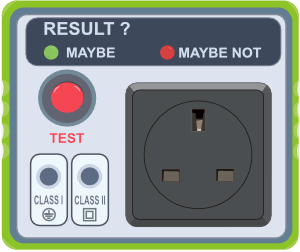Pass - Fail PAT Testers

There are a number of test instruments available with single button operation that provide a simple pass or fail result. These testers usually carry out just the basic earth continuity and insulation resistance tests, but do not display the actual measured value. They are often marketed as easy to use PAT testers for beginners. The biggest problem with this type of tester is the earth continuity measurement. The correct limit for this is 0.1Ω plus the resistance of the cable. A 25m, 2.5mm2, extension reel for example can have a resistance of 0.3Ω, but for an appliance fitted with 1m 1.5mm2 cable, the maximum limit is 0.11Ω. Unfortunately with a pass/fail type tester there is no way to make an allowance for the resistance of the cable. To overcome this these machines usually have a limit set to an arbitrary value higher than the standard 0.1Ω. One test instrument currently available has the limit set to 10Ω. This is 100 times higher than the 0.1Ω limit set out in the IET Code of Practice. The IET Code of Practice briefly mentions pass/fail testers:
“Some portable appliance test instruments with go/no-go indication may fail a cable connected appliances with earth continuity resistance exceeding 0.1Ω. If it is not possible to reprogramme the appliance test instrument it will be necessary for a measurement of the actual resistance to be made with another instrument." - IET Code of Practice
The insulation resistance test is often a compromise also. This test should be carried out at 500Vdc for most equipment, but some appliances may require a 250Vdc test. Some pass/fail PAT testers can only carry out a 500Vdc test, whilst others use an in between value such as 350Vdc. However, one particular pass/fail tester uses a mere 9Vdc test voltage with a limit set to 1MΩ for both Class I and Class II equipment types!
It’s clear that these machines are designed to be easy to use with little or no training, but unfortunately, they will never carry out a test that meets the requirements of the IET Code of Practice. Some are better than others. One popular model has the option to set the earth continuity pass limit to either 0.25 Ω for shorter cables or 0.5Ω for longer cables, which seems a reasonable compromise. But a machine that has a limit of 10Ω and a test current of 2.3mA for earth continuity and a 9v insulation test is not a PAT tester.
Spend a little more and you can get a PAT tester that will actually display the test reading as well as a pass or fail indication. In some cases, the test instrument may indicate an incorrect result, but a trained user will be able to interpret the actual measured value.
While pass/fail PAT testers attempt to offer a simplified approach to testing, they have limitations in providing correct test results. To fully understand and accurately interpret these results, attending a PAT testing course is highly recommended. Our PAT courses not only provide in-depth knowledge about using various PAT testing instruments but also ensure that you are equipped with the skills to make informed decisions based on the test outcomes. This is essential for anyone responsible for ensuring the safety of electrical equipment in the workplace.